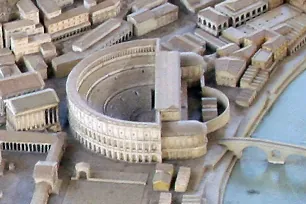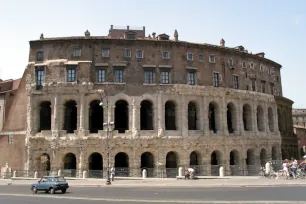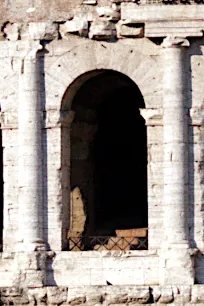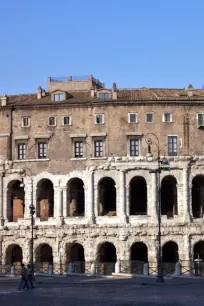The Theater of Marcellus was built in 13 BC by Emperor Augustus and named in honor of Marcellus, his intended heir. The theater was the largest in ancient Rome.


After Julius Caesar defeated Pompey in the struggle for control over Rome, he wanted to build a theater rivaling the Pompey theater, which Caesar’s his bitter enemy had built in 55 BC. When Caesar was killed in 44 BC, the project had only just started.
In 22 BC, Augustus – known as the emperor who turned Rome from a city of brick into a city of marble – restarted the project.
Marcellus
The new theater, the largest of the Roman Empire, was finally dedicated in 13 BC and named Theatrum Marcelli in memory of Marcellus, the son of Augustus’ sister Octavia. Marcellus was the intended heir of Augustus, but he died at a young age.


The Building
When completed in 11 BC, the semicircular theater was more than 30 meters (98 ft.) high. Its seating area, the cavea, had a diameter of 130 meters (426 ft.). The Theater of Marcellus could accommodate more than 14,000 spectators, of whom 12,000 were seated.
The design of the theater, with its multiple levels of arches supported by columns, was a model for the Colosseum, which was built decades later. Each of the three levels had a different architectural style: the first level had fifty-two open arches supported by columns in the Doric Order; the second featured arches with Ionic columns and the third one consisted of a closed wall with pilasters in the Corinthian Order. The structure was mainly built of tufa, cement and brickwork. The cavea was sheathed in white travertine.
The Theater in the Middle Ages
In the twelfth century, the Theater of Marcellus was owned by the Fabii family, who turned the theater into a fortress. In 1368 the building was acquired by the Savelli family, who asked architect Baldassare Peruzzi to transform the building into a fortified palazzo. In the seventeenth century, the palazzo fell into the hands of the Orsini.
As a result of all the modifications that were made over the centuries, only a section of the first two levels of the original theater are still visible today.
- Next: Porta Maggiore
- More Rome Ancient Sights
- More Sights & Attractions in Rome

